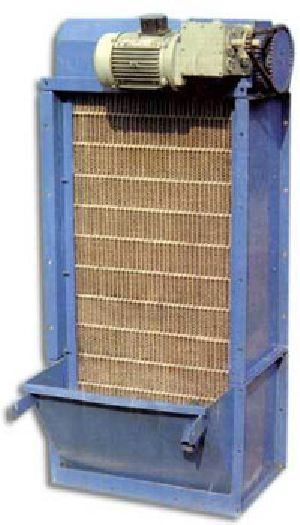
Viscous Air Filter
Auto Viscous filter is a self-cleaning viscous air filter using a rotating curtain of metal screen as the filtering media. Behind the filter media roll is an endless roll of oil drop eliminator. When the filter media is loaded and the pressure drop increases, a totally enclosed thermally protected geared motor moves the filter media and oil drop eliminator which pass through a viscous oil bath located at the bottom of the filter. The viscous oil cleans the filter media and the oil drop eliminator ensures that the oil is not carried into the air stream. The sludge collected in the oil bath needs to be cleaned periodically.These filters are especially advantageous wherever dust concentration in the surrounding air is comparatively heavier as in Goal and lignite mines, steel plants, Chemical plants, Cement plants, foundries and other similar Industries. Dust Arrestance: 90% as per B.S.2831 test dust No.IIIRecommended Air Velocity : 2.5 m/sec. Recommended working temp.: 60⁰ C Max.Recommended Oil to be used: Light mobil vectra oil or equivalentInitial Pressure Drop : 4 - 5 mm wg.Final Pressure drop : 8 - 10 mm wg.Rotation Frequency: 30 sec ON, 10 min OFFGear Box: Mono Drive – 5Motor: 0.55 KW, 3 Phase, 415 Volts, 50 Hz
...more
Ventilation System
Ventilation is the process by which ‘clean’ air (normally outdoor air) is intentionally provided to a space and stale air is removed. This may be accomplished by either natural or mechanical means.Industrial ventilation is a method of controlling worker exposure to airborne toxic chemicals or flammable vapors by exhausting contaminated air away from the work area and replacing it with clean air.Ventilation is needed to provide oxygen for metabolism and to dilute metabolic pollutants (carbon dioxide and odour). It is also used to assist in maintaining good indoor air quality by diluting and removing other pollutants emitted within a space but should not be used as a substitute for proper source control of pollutants. Ventilation is additionally used for cooling and (particularly in dwellings) to provide oxygen to combustion appliances. Good ventilation is a major contributor to the health and comfort of building occupants. Design Parameter to be considered for Air Quantity will be based on:- ASHRAE Ventilation Standard or Air Change Rate (ACH)- Area and occupancy a) An Exhaust/Extraction system is designed to remove foul air, usually at high level, unless the fumes are heavier than air, when extraction would take place near floor level. This extraction creates an area of negative pressure causing the fresher replacement air to flow into the room through doors, windows, or through suitably spaced low level intake grilles. This is by far the most common, economical and simplest system for normal ventilation work.b) An Intake/Treated Fresh Air system - blows in fresh air, which mixes with the air already in the room and forces its way out to the atmosphere through any available openings. Careful location and speed control of intake fans and evenly distributed air supply diffusers are necessary to prevent draughty conditions. Even in warm weather, incoming air may need to be tempered and/or filtered, in which case careful planning should be given to the position of the diffusers. If filtered air is required, an intake system is essential, and the room should be under a slight positive pressure, so that any leakage of air is outwards from the room. c) A Combined system/Dilute Ventilation system using both exhaust and supply systems can be more effective than extract only in large offices, as controlled mechanical intake can be used to give positive gentle air movement in warm weather to create a feeling of freshness. It also reduces the number and size of openings required in the structure for replacement fresh air. Heat Recovery units can be incorporated in this type of system for energy saving during the Winter months and under certain conditions, a degree of cooling during spring and early summer. Where buildings are air conditioned, these savings will continue in the summer. Positive pressure is when a room inside the building is held at a higher pressure than the surrounding rooms. Or to put it another way, positive pressure occurs when more airflow is pumped into a room than airflow drawn out. This ensures any air leaks in the room will flow from inside the room to the outside. This is most commonly used in clean room applications to prevent airborne contaminants from outside the room leaking in. Negative pressure is when a room inside the building is held at a lower pressure than the surrounding rooms. Or to put it another way, negative pressure occurs when more airflow is drawn out of a room then airflow pumped in. This ensures any air leaks in the room will flow from outside the room to the outside. This is most commonly used in hospital isolation rooms to prevent airborne viruses or bacteria from escaping the room into other rooms. Design Considerations of Air Change Rates Trouble shooting of various types of ventilation systems Background NOISE Levels Generated by various activities and areas Ionization System Ventilation System Clean Room Equipments Air Pressurizing System Axial fans & Centrifugal Blowers Paint Booth Wet Scrubber Viscous Air Filter Pulse Jet Bag Filter
...more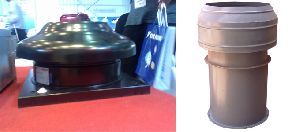
Roof Extractors
Roof Extractors are particularly recommended in India where more than one side of the shop is fully open to the atmosphere, thereby having an excellent air input. The hot air tends to rise upwards and when it is extracted through the Roof Unit; there is substantial inflow of fresh air which causes a reduction in the room temperature
...more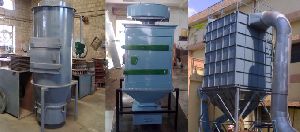
pulse jet bag fitter
Recovery of particulate matter from exhaust gas is vital for any industry from two aspects• To avoid pollution problems• Recovery of finished product-increasing the plant yieldFor recovering particulate matter different options available are – Cyclones, Venturi, scrubbers, bag filters, electrostatic precipitators etc. Out of these bag filter becomes the best choice if following are dominant selection criteria’s:• Material is expensive and hence high collection efficiency is desired.• Particulate size is very fine.• Material recovery in powder form is desirable & not in solution form.A conventional bag filter normally has following problems:• Frequent bag choking - hence high plant shut down time.• Higher pressure drops across bag filter – hence higher blower electrical power.• Bag choking resulting in reduced airflow rate & therefore reduction in plant capacity.Due to the above the bag filter becomes bottleneck for plant operation. Realizing above we have designed our bag filter using scientific procedure as elaborated in DESIGN METHODOLOGY. We manufacture bag filter as per "Quality Assurance Plan." Hence consistency in quality is guaranteed. 1. The air enters the bag filter bustle.2. The air is uniformly distributed avoiding channeling.3. Initially a coat of material forms on the bags. Subsequently, the coat acts as the filtering medium.4. The dust is accumulated on filter elements while the air passes thorough the filter bags from outside to inside.5. The accumulated powder is dislodged from the bags by reverse pulse-jet air intermittently.6. The dislodged powder falls on bottom cone and is discharged through powder discharge valves.7. The dust free air is sucked by induced draft fan and is exhausted to atmosphere.
...more
Pulse Jet Bag Filter
Recovery of particulate matter from exhaust gas is vital for any industry from two aspects * To avoid pollution problems * Recovery of finished product-increasing the plant yield
...more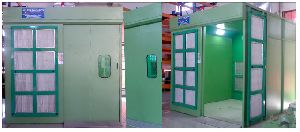
Paint Booth
A paint booth is a structure which is designed to keep dust and other contaminants out of a painting area. Contaminants can have a major impact on the quality of a paint job, whether the paint is being applied to a piece of porcelain or a commercial aircraft. Using paint booths ensures that paint jobs are done quickly and in a clean environment. 1. Open front booths.As the name implies, open front booths are not fully enclosed. These are the most common paint booths for smaller shops and general manufacturing and industrial spray collection. Three walls and a ceiling contain the overspray and fumes, and a fan in the back wall draws room air past the work area and out through an exhaust filter.2. Crossflow booths.These fully enclosed booths use a horizontal stream of air to collect fumes and particles. An intake filter on one side cleans incoming air, and an exhaust filter cleans it again before it's vented outside the booth.3. Downdraft booths.The most effective overall, downdraft booths are fully enclosed just like crossflow booths. However, incoming air is drawn through ceiling-mounted filters. There are several variations on the downdraft design: some use pits below the floor to draw air straight down, while others use "semi-downdraft" or "side downdraft" designs that pull incoming air down and to the sides or back of the booth.They all contain intake & exhaust filters. Intake filters clean the air coming into the booth and the exhaust filters filter the air leaving the booth.Some paint booths have their own heated or non-heated air replacement unit making them a positive pressure booth. A paint booth that has positive pressure keeps unwanted dirt and debris from entering the booth through week caulk joints or door seals. Ionization System Ventilation System Clean Room Equipments Air Pressurizing System Axial fans & Centrifugal Blowers Paint Booth Wet Scrubber Viscous Air Filter Pulse Jet Bag Filter
...more
Odour Control Systems
Carbon filters phenomenal absorbent capacity has been in use as a purifying agent for air and are suitable for a wide range of odour control & volatile organic compounds abatement applications including Kitchen Extract Systems, Sewage Treatment Plants, Abattoirs, Office Air Intake Systems, Airports, Museums & Galleries.
...more
humidification systems
Features- * Air velocity through washer 2.5 ms * Water pressure required for spray nozzles 140 - 170 kNm2 * Water pressure required for flooding nozzles 30 - 70 kNm2
...more
Electrostatic Precipitator
As air enters the electrostatic precipitator, the particles pass through an electrical field that gives an electrical charge to the particles. The charged particles pass through a series of alternately charged collector plates. Particles are repelled by plates with the same polarity and attracted to plates with opposite polarity — similar to how a powerful magnet works.Dual-stage electrostatic precipitators include two parts: the charging and the collecting sections. In the charging section, the incoming smoke, grease, mist, and other particulates pass by ionizer wires which impart a positive electrical charge to these contaminants. The positively charged contaminants are then drawn through the collection section which contains a secondary electrical field with negatively charged aluminum plates. Since opposite charges attract, the positively charged contaminants collect on the negatively charged aluminum plates, removing them from the air stream.Air velocity: 1.5 - 2.5 m/s • ESPs are very efficient (up to 99% efficiency)• This is more effective to remove very small particles like smoke, mist and fly ash. Its range of dust removal is sufficiently large (0.01 micron to 1.00 micron). • This is also most effective for high dust loaded gas (as high as 100 grams per cu. meter)• The draught loss of this system is the least of all forms(1 cm of water)• The dust is collected in dry form and can be removed either dry or wet.• They are generally more economical than other particulate control devices:Operating costs are reduced by low energy consumption, minimal maintenance requirements and reduced cost on spare parts• Can be designed to handle wet and dry gas compositions • Can handle large volumes of gas flow with low pressure drop • Can function at high temperatures (as high as 700 degree F – 1300 degree F)• Pressure and temperature changes are small• Difficult material like acid and tars can be collected• They withstand extremely corrosive material• Low power requirement for cleaning• Dry dust is collected making recovery of lost product easy• Large flow rates are possible• It provides ease of operation. • High initial capital costs• Dry ESPs can only control particulate emissions, not gas composition emissions• Once installed, ESPs take up a lot of space and cannot be easily redesigned• May not work properly on high electrical resistive particles• Materials with very high or low resistivity are difficult to collect• Inefficiencies could arise in the system due to variable condition of airflow (though automatic voltage control improves collector efficiency) • They can be larger than bag Filters (fabric collectors) and cartridge units, and can occupy greater space• Dust loads may be needed to be reduced before precipitation process (pre-cleaner may be needed)• The direct current is not available with the modern plants, therefore considerable electrical equipment is necessary to convert low voltage (400 V) A.C to high voltage (60000 V) D.C. This increases the capital cost of the equipment as high as 40 to 60 cents per 1000 kg of rated installed steam generating capacity.• The running charges are also considerably high as the amount of power required for charging is considerably large.• The efficiency of the collector is not maintained if the gas velocity exceeds that for which the plant is designed. The dust carried with the gases increases with an increase of gas velocity.• Because of closeness of the charged plates and high potential used, it is necessary to protect the entire collector from sparking by providing a fine mesh before the ionizing chamber. This is necessary because even a smallest piece of paper might cause sparking when it would be carried across adjacent plates or wires
...more
Dehumidifiers
Dehumidification is the process of absorbing moisture from the atmospheric level and it is necessary in the various manufacturing, packing & Storage of variety of engineering & food products. In addition to comfort air conditioning. The resulting reduction of relative humidity helps to prevent rust & corrosion in engineering Industry, bacteria (fungus) formation in food processing industry as well as pharmaceutical products.
...more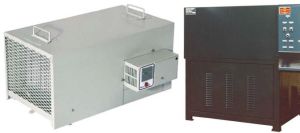
dehumidification
Dehumidification is the process of absorbing moisture from the atmospheric level and it is necessary in the various manufacturing, packing & Storage of variety of engineering & food products. In addition to comfort air conditioning. The resulting reduction of relative humidity helps to prevent rust & corrosion in engineering Industry, bacteria (fungus) formation in food processing industry as well as pharmaceutical products. De-humidification is normally achieved either by passing air over a cooling coil whose surface temperature is less than the dew point temperature of air or by chemical absorption of moisture in the air.A simple design of de-humidifier consists of a compressor, finned condenser and cooling coil, capillary, air circulating fan with motor, cabinet to house components & means to dispose off the condense. The physical construction of the system is almost similar to that of window air – conditioner.The moist room air is drawn through the cooling coil / evaporator & cooled to a temperature below its dew point thus removing the moisture which is drained off. The cooled air is then allowed to pass over the condenser (also known as reheat coil) where the air is heated sensibly and discharged into the room at a higher temperature but at a lower relative humidity. This being a continuous cycle the relative humidity in the room is gradually lowered to the desired level, which is controlled by a electronic digital RH controller. Iron & steel will not rust if the air in contact with the surface has a relative humidity below 50%. Dehumidification is often a better & less expensive way to protect investments than painting the objects that are protected by dehumidification. Moisture will not condensate on a surface if the air in contact with it has a dew point lower than the surface temperature. Condensation can lead to many problem such as corrosion or short circuit in electrical systems. Ice will not form on a surface if the air in contact with it has a dew point lower than the surface temperature. Ice formation is a problem in for example cold storages where it will cause a lower efficiency in the cooling machinery. Dehumidification will keep the Ice away. Mould & fungus formation is prevented if the surrounding air is kept below 70% RH. This is important in many situations for e.g., in storage of wooden products, in houses, designed with a crawl space it is often necessary to use a dehumidifier to keep mould and fungus from formatting. Bacteria need humidity required for bacteria to multiply is found on hygroscope materials. If the surrounding air is held below 50% RH most bacteria will not find a suitable environment to multiply. Bad smell will drastically be reduces if the RH is kept below 50%. For e.g., Sewage Stations the odour can often be controlled by installing a dehumidifier. Dehumidification is an on going process to reduce and keep the air moisture low at an enclosed space.
...more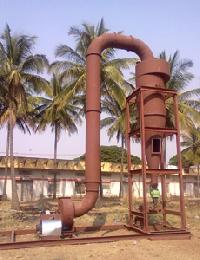
Cyclone Separators
They are contraptions that makes use of centrifugal forces along with tiny quantities of pressure by way of a turning movement to divide dust particles into categories. The entire process of the cyclone and how the separators function is quite interesting. The selected substance is pushed at elevated levels into the pipe entering the device. The robust form of the filter makes the incoming substance spin into a vortex. Bigger more textured particles are swept towards the outer barriers of the cyclone. Then it is spun in the air as heavy particles are pushed into another section. The thinner particles are released at the top. The process taken by the model uses a constant flow.
...more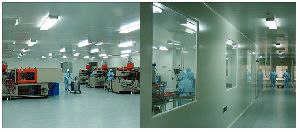
cleanroom equipment
A cleanroom is an environment, typically used in manufacturing or scientific research, that has a low level of environmental pollutants such as dust, airborne microbes, aerosol particles and chemical vapors. More accurately, a cleanroom has a controlled level of contamination that is specified by the number of particles per cubic meter at a specified particle size. To give perspective, the ambient air outside in a typical urban environment might contain as many as 35,000,000 particles per cubic meter, 0.5 μm and larger in diameter, corresponding to an ISO 9 cleanroom.Cleanrooms can be very large. Entire manufacturing facilities can be contained within a cleanroom with factory floors covering thousands of square meters. They are used extensively in semiconductor manufacturing, biotechnology, the life sciences and other fields that are very sensitive to environmental contamination.The air entering a cleanroom from outside is filtered to exclude dust, and the air inside is constantly recirculated through high efficiency particulate air (HEPA) and ultra low penetration air (ULPA) filters to remove internally generated contaminants. Staff enter and leave through airlocks (sometimes including an air shower stage), and wear protective clothing such as hats, face masks, gloves, boots and cover-alls.Equipment inside the cleanroom is designed to generate minimal air contamination. There are even specialised mops and buckets. Cleanroom furniture is also designed to produce a minimum of particles and to be easy to clean.Common materials such as paper, pencils, and fabrics made from natural fibers are often excluded; however, alternatives are available. Cleanrooms are not sterile (i.e., free of uncontrolled microbes)[1] and more attention is given to airborne particles. Particle levels are usually tested using a particle counter.Some cleanrooms are kept at a positive pressure so that if there are any leaks, air leaks out of the chamber instead of unfiltered air coming in.Some cleanroom HVAC systems control the humidity to relatively low levels, such that extra precautions are necessary to prevent ESD electrostatic discharge problems. These ESD controls ("ionizers") are also used in rooms where ESD sensitive products are produced or handled.Low-level cleanrooms may only require special shoes, ones with completely smooth soles that do not track in dust or dirt. However, shoe bottoms must not create slipping hazards (safety always takes precedence). Entering a cleanroom usually requires wearing a cleanroom suit.In cheaper cleanrooms, in which the standards of air contamination are less rigorous, the entrance to the cleanroom may not have an air shower. There is an anteroom, in which the special suits must be put on, but then a person can walk in directly to the room (as seen in the photograph on the right).Some manufacturing facilities do not use fully classified cleanrooms, but use some cleanroom practices together to maintain their cleanliness requirements. The new world standard, ISO 14644: Cleanrooms, represent an internationally accepted set of standards recognised in the world markets. Its approximate equivalents in the old standards are as follows:
...more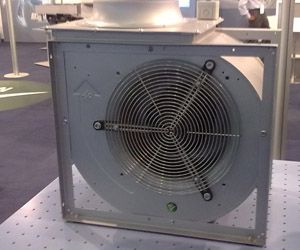
Centrifugal Fans
Centrifugal fans consist of a wheel or a rotor mounted on a shaft that rotates in a scroll-shaped housing. Air enters at the eye of the rotor, makes a right-angle turn, and is forced through the blades of the rotor by centrifugal force into the scroll-shaped housing. The centrifugal force imparts static pressure to the air. The diverging shape of the scroll also converts a portion of the velocity pressure into static pressure.There are three main types of centrifugal fans:• Radial blade fans - Radial-blade fans are used for heavy dust loads. Their straight, radial blades do not get clogged with material, and they withstand considerable abrasion. These fans have medium tip speeds and medium noise factors.• Backward curved blade fans - Backward-blade fans operate at higher tip speeds and thus are more efficient. Since material may build up on the blades, these fans should be used after a dust collector. Although they are noisier than radial-blade fans, backward-blade fans are commonly used for large-volume dust collection systems because of their higher efficiency.• Forward curved blade fans - These fans have curved blades that are tipped in the direction of rotation. They have low space requirements, low tip speeds, and a low noise factor. They are usually used against low to moderate static pressures. Dynamically balanced as per VDE 2060 Vibration within limits as per VDI 2056 Aerodynamic Performance as per IS/BS/AMCA standards
...more
Centrifugal Blowers
A fan is a device that is designed to move a specific volume of air (flow) against moderate pressure (resistance). A fan induces an airflow by virtue of its blades; a blade moves air by generating a lift force when in motion through the air.
...more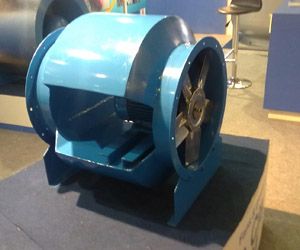
Bifurcated Fans
The Bifurcated fans having cast Aluminum alloy impeller, aero foil section blade with MS Casing. This fan is mostly placed to exhaust or supply the air of corrosive nature or hazardous for the motor. In this the motor is not the stream of air, this remain protected from the particles available in the air.
...more
Axial fans & Centrifugal Blowers
A fan is a device that is designed to move a specific volume of air (flow) against moderate pressure (resistance). A fan induces an airflow by virtue of its blades; a blade moves air by generating a lift force when in motion through the air. An axial flow fan is a fan in which the flow of air is substantially parallel to the axis of rotation.The three main kinds of axial fans are-• Propeller fans - These fans are used to move large quantities of air against very low static pressures. They are usually used for general ventilation or dilution ventilation and are good in developing up to 0.5 in. wg • Tube-axial fans - Tube-axial fans are similar to propeller fans except they are mounted in a tube or cylinder. Therefore, they are more efficient than propeller fans and can develop up to 3 to 4 in. wg). They are best suited for moving air containing substances such as condensable fumes or pigments.• Vane-axial fans - Vane-axial fans are similar to tube-axial fans except air-straightening vanes are installed on the suction or discharge side of the rotor. They are easily adapted to multistage and can develop static pressures as high as 14 to 16 in. wg. They are normally used for clean air only. Low vibrations as per VDI 2056. Aerodynamic Performance tested as per BS 848 Part-1 (1980) Sound Performance tested as per BS 848 Part-2 1985.
...more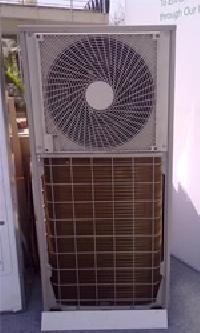
Air Conditioning System
This is a process of controlling the air temperature, relative humidity, ventilation, air movement and air cleanliness of a given space in order to provide the occupants with a comfortable indoor temperature. It consists of a group of components or equipment connected in series to control the environmental parameters.
...more
Fume Extraction System
Fume Extraction System addresses the issue of avoiding the contamination of indoor air by specific high-emission sources by capturing airborne contaminants before they are spread into the environment.
...more
Air Ionizer
We are leading manufacturer and supplier of huge range of Air Ionizer.
...more
electrostatic precipitators
As air enters the electrostatic precipitator, the particles pass through an electrical field that gives an electrical charge to the particles. The charged particles pass through a series of alternately charged collector plates. Particles are repelled by plates with the same polarity and attracted to plates with opposite polarity — similar to how a powerful magnet works.
...more
Wet Scrubber
Air scrubbers are commonly used in process-air applications to eliminate potentially harmful dust and pollutants. A liquid, in general water added with active chemicals adapted to the process, is sprayed in to the air flow. Aerosol and gaseous pollutants in the air stream are removed by either absorption or chemical reactions with the water solution.
...more
Cleanroom Equipments
We deals in manufacturing and supplying of wide range of Cleanroom Equipments.
...more
Air Filter
Mechanical device that removes contaminants from the air stream.
...more
HVAC Duct Cleaning
We are well known for manufacturing and supplying of wide variety of hvac duct cleaning.
...moreBe first to Rate
Rate ThisOpening Hours